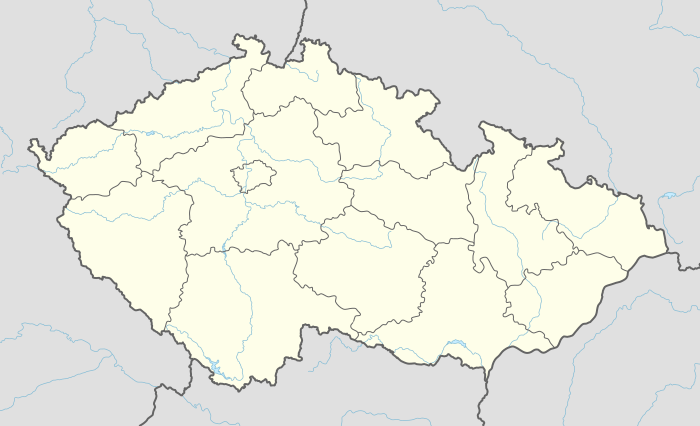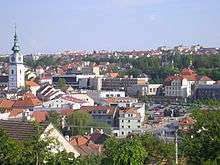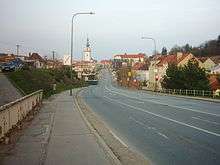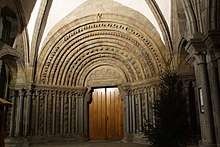Třebíč
Třebíč (Czech pronunciation: [ˈtr̝̊ɛbiːtʃ] (![]()
Třebíč | |
|---|---|
Town | |
 Aerial view of center of Třebíč | |
 Flag  Coat of arms | |
| Etymology: from name Třebek | |
| Nickname(s): Třeb | |
 Třebíč Location in the Czech Republic | |
| Coordinates: 49°12′54″N 15°52′54″E | |
| Country | |
| Region | Vysočina |
| District | Třebíč |
| First mentioned | 1277 |
| Government | |
| • Mayor | Pavel Pacal |
| Area | |
| • Total | 57.6 km2 (22.2 sq mi) |
| Elevation | 405 m (1,329 ft) |
| Population (2020-01-01[1]) | |
| • Total | 35,451 |
| • Density | 620/km2 (1,600/sq mi) |
| Time zone | UTC+1 (CET) |
| • Summer (DST) | UTC+2 (CEST) |
| Postal code | 674 01 |
| Website | www.trebic.cz |
| Official name | Jewish Quarter and St. Procopius' Basilica in Trebíc |
| Criteria | ii, iii |
| Reference | 1078 |
| Inscription | 2003 (27th session) |
In the age of its expansion, Třebíč was the third most important town in Moravia. The population growth started after World War II.
There are several well-known tourist sights in the town. The Jewish Quarter and St. Procopius Basilica are listed as a UNESCO World Heritage Site.
The beginnings of the town's history are connected with the establishment of a Benedictine monastery, where the castle is located today.
History and sights

The historical treasury of Třebíč includes the old Jewish Quarter and the large Romanesque St Procopius' Basilica, which incorporates some later Gothic features, including a rare example of a ten-part (also known as 'botanical') rose window. Such designs reflect the five or ten parts of the family Roseaceae flowers and fruit, based on their five sepals and petals or the usual ten segments of their fruit. Botanical rose windows contrast with more complex Gothic windows that contain more segments (usually multiples of traditional gothic units of design – three trefoil, or four quatrefoil). Another thesis says that these decorations are based on an ancient design, inspired by forerunners in the wheel of life, associated with eastern religions nowadays, or may allude to the Virgin Mary.
The famous Basilica originated in the early 12th century as a Benedictine monastery. It was endowed so well, that it led to the establishment of a local commercial centre; the town of Třebíč. The monastery was rebuilt during the reign of King Wenceslas I (1230–53), and again at the end of the fifteenth century. During the first half of the 16th century some of Třebíč's historic monastic buildings were remodeled into a castle, and were later renovated in Baroque style.
In the early eighteenth century changes were introduced on the basilica by the Czech architect Frantisek Maxmilian Kanka; windows were enlarged, buttresses were added, a southwest tower was rebuilt, and a new west front with two towers was constructed in a gothic baroque style.
The historical town of Třebíč, which extends on both sides of the river Jihlava, was declared a Conservation Area in 1990. The Jewish Quarter and St. Procopius Basilica together with the castle and gardens, are all included within the Trebic Conservation Area.
History in dates
- 1101 Establishment of Benedictine Monastery.
 Komenského Square and a municipal tower, west side of Karlovo Square is visible in the left corner, cultural complex Forum is in the middle.
Komenského Square and a municipal tower, west side of Karlovo Square is visible in the left corner, cultural complex Forum is in the middle. - 1277 The oldest deed mentioning the town of Třebíč.
- 1335 Conferring of town rights to Třebíč according to the royal town of Znojmo.
- 1338 First references of Jewish settlement.
- 1468 Třebíč was conquered and destroyed by Matthias Corvinus of Hungary.
- 19th century Expansion of tannery and shoemaking.
- 1871 Opening of Národní dům (National House), establishment of grammar school with Czech as teaching language (Gymnázium Třebíč).
- 1886 First train runs through Třebíč.
- 1930 Development of shoe making production and construction of workers' colonies – present Borovina
- 1970s – 80s The town is stigmated by the construction of new housing estates, population increases.
- 1990s Fast renovation of the town.
- 2003 Registration of Jewish Quarter and St. Procopius' Basilika into UNESCO List of Cultural and Natural Heritage
Geography
Třebíč is situated 35 km southeast of Jihlava and 65 km west of Brno on the Jihlava River. The town's elevation is between 392 and 503 metres above sea-level.
Třebíč has a temperate climate with occasional rains. Average annual temperature is 7.5 °C, average temperature in July is 18.5 °C and −3.4 °C in January.
Demography
| Progress of population[2][3][4] | |||
|---|---|---|---|
| Year | Population | ||
| 1763 | 3 149 | ||
| 1772 | 3 439 | ||
| 1791 | 4 743 | ||
| 1799 | 5 010 | ||
| 1830 | 6 005 | ||
| 1835 | 6 731 | ||
| 1843 | 6 803 | ||
| 1849 | 7 800 | ||
| 1850 | 8 002 | ||
| 1869 | 10 328 | ||
| 1880 | 11 999 | ||
| 1890 | 13 726 | ||
| 1900 | 15 309 | ||
| 1910 | 16 347 | ||
| 1921 | 17 191 | ||
| 1930 | 17 555 | ||
| 1950 | 20 257 | ||
| 1960 | 20 387 | ||
| 1970 | 22 555 | ||
| 1980 | 29 017 | ||
| 1985 | 36 008 | ||
| 1991 | 38 355 | ||
| 2001 | 39 021 | ||
| 2005 | 38 715 | ||
| 2008 | 38 717 | ||
| 2014 | 37 095 | ||
| 2015 | 36 641 | ||
| 2019 | 35 691 | ||
Town divisions

- Borovina (526 houses, 5,864 inhabitants)
- Budíkovice (61 houses, 199 inhabitants)
- Horka Domky (1,158 houses, 7,788 inhabitants)
- Jejkov (91 houses, 270 inhabitants)
- Nové Dvory (987 houses, 16,657 inhabitants)
- Nové Město(161 houses, 1,056 inhabitants)
- Pocoucov (59 houses, 183 inhabitant)
- Podklášteří (1,009 houses, 3,899 inhabitants)
- Ptáčov (66 houses, 212 inhabitants)
- Račerovice (49 houses, 155 inhabitants)
- Řípov (22 houses, 68 inhabitants)
- Slavice (80 houses, 246 inhabitants)
- Sokolí (44 houses, 88 inhabitants)
- Stařečka (202 houses, 539 inhabitants)
- Týn (203 houses, 1,171 inhabitants)
- Vnitřní Město (53 houses, 210 inhabitants)
- Zámostí (124 houses, 416 inhabitants)
Transport

Important trade routes, that had been leading near Třebíč already in ancient times were called: Habry Route, Lovětín Route and Libice Route.
Nowadays, Třebíč is an important traffic junction of the region. The main roads crossing Třebíč are I/23 (Brno – České Budějovice) and II/360, which connects Třebíč with the highway D1. Road II/405, passing near the town, connects Třebíč with the capital city of Vysočina Region – Jihlava.
The railway has the east–west direction in Třebíč. This railway No. 240 connects Třebíč with cities of Brno and Jihlava. There are two train stations serving the town: Třebíč and Třebíč-Borovina.
There is the small sport airport in the outskirts.
A trolley line was proposed in the past but has never been built.
In Třebíč there are several segregated cycle facilities, including a bike route leading from Jihlava to Raabs an der Thaya, which was built in 2009.
Culture
Festivals
- Theatre Třebíč (Divadelní Třebíč) – festival of Amateur theatre
- Šamajim – festival of Jewish culture
- Třebíč potato festival (Bramborobraní) – folklore festival – music and dance
- Jubilee Unesco (Oslavy Unesco) – jubilee celebration of town entrance to the UNESCO list
- Theatre 2-3-4 actors (Divadla 2-3-4 herců) – festival of professional theatre
- Zámostí – cultural and music festival[5]
- Concentus Moraviae – concerts of classical music
Education
- Universities
- Secondary schools
- Gymnázium Třebíč
- Střední průmyslová škola Třebíč (Second industrial school Třebíč)[6]
- Katolické gymnázium Třebíč (Catholic gymnasium Třebíč)[7]
- Obchodní akademie Dr. Albína Bráfa[8]
- Vyšší odborná škola a Střední škola veterinární, zemědělská a zdravotnická Třebíč[9]
- Hotelová škola Třebíč[10]
- Střední škola stavební Třebíč[11]
- Střední škola řemesel Třebíč[12]
- Soukromá střední odborná škola a Střední odborné učiliště
Notable people
- Leopold Löw (1811–1875), Hungarian rabbi
- Friedrich Leo von Rottenberger (1872–1938), Austrian landscape architect
- Jan Syrový (1888–1970), general and politician, prime minister (1938)
- Jan Zahradníček (1905–1960), poet
- Jindřich Svoboda (1917–1942), Czech bomber captain in the RAF
- Jaroslav Zvěřina (born 1942), politician
- Pavel Padrnos (born 1970), road racing cyclist
- Patrik Eliáš (born 1976), ice hockey player
- Martin Erat (born 1981), ice hockey player
- Theodor Gebre Selassie (born 1986), footballer
- Vladimír Sobotka (born 1987), ice hockey player
- Jitka Válková (born 1991), Czech Miss winner
Twin towns – sister cities
Třebíč is twinned with:[13][14]





Gallery
 Portal of St Procopius' Basilica
Portal of St Procopius' Basilica Interior of the St. Procopius Basilica in Třebíč
Interior of the St. Procopius Basilica in Třebíč Abbacy of St Procopius' Basilica in Třebíč
Abbacy of St Procopius' Basilica in Třebíč_in_T%C5%99eb%C3%AD%C4%8D%2C_T%C5%99eb%C3%AD%C4%8D_District.jpg) Interior of the Jewish Synagogue in Třebíč
Interior of the Jewish Synagogue in Třebíč- Statue of Saints Cyril and Methodius
References
- "Population of Municipalities – 1 January 2020". Czech Statistical Office. 30 April 2020.
- Soubor školních map 1:100 000 – OKRES TŘEBÍČ, Kolektiv autorů, Geodetický a kartografický ústav v Praze, n. p. for ONV Třebíč, 1987, First edition, 20/34 pages, language: czech
- Třebíč – Dějiny města II, Jan Janák, illustrations Božena and Josef Kremláček, Blok Brno for ZMM in Třebíč, 1981, First edition, 224 pages, language: czech
- "Czech Statistical Bureau Document - Demographics". ČSÚ.
- Zamosti.cz Zamosti.cz
- Spst.cz
- KGtrebic.cz
- Oatrebic.cz
- Szstrebic.cz
- Sosos.cz
- Spsstavebni.trebic.net
- Sour-tr.euweb.cz
- "Partnerská města" (in Czech). Město Třebíč. Retrieved 25 June 2020.
- "Čínské město I-čchang požádalo partnerské město Třebíč o pomoc s koronavirem" (in Czech). Český rozhlas. 28 January 2020. Retrieved 25 June 2020.
External links
| Wikimedia Commons has media related to Třebíč. |
- Municipal website in English
- Trebic.cz/unesco – UNESCO in Třebíč town (cz, de, en, fr)
- Zamek-trebic.cz – Vysočina Museum in Třebíč (cz)
- Photos of Třebíč and Background Information (en)
- Basilica of St. Procopius in Třebíč (en)
- Jewish Ghetto in Třebíč (en)
- Třebíč, Czech Republic at JewishGen